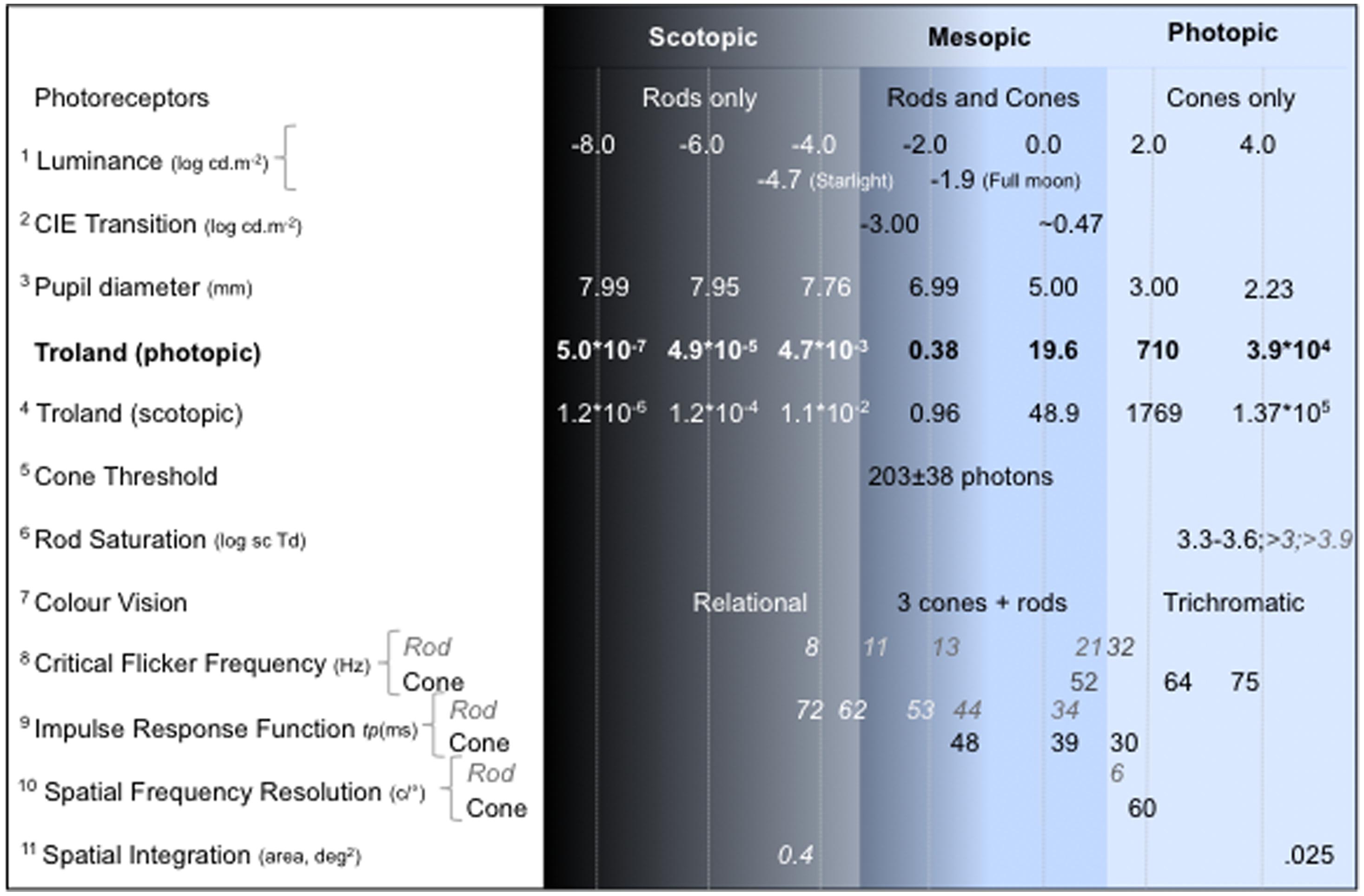Page 1 of 1
Seeing colours?
Posted: Tue Jun 30, 2020 10:36 pm
by turboscrew
I'm not sure this is really a beginner question, but I didn't find a better place...
Does anyone happen to know "typical" criteria of seeing colours?
I was thinking that there probably needs to be intense enough light (the low light cells don't "see" colours, sorry for not remembering the names of the cells in English), and I guess there needs to be big enough lit area too to tell the colour?
Re: Seeing colours?
Posted: Tue Jun 30, 2020 10:45 pm
by JayTee
Your light detecting cells are rods and cones. Cones begin with the letter "C" and so does the word "c"olor, that's how I remember them.
For DSO colors, some folks claim that you can begin to get a hint of color at 12" of aperture. Most people will routinely see color at 20" of aperture in particular objects like planetary nebula and globular clusters.
Cheers,
JT
Re: Seeing colours?
Posted: Tue Jun 30, 2020 11:10 pm
by Gfamily
Extended objects will rarely show colour, but there are binaries that show distinctly different colours - probably the best one to see this is Albireo, which is the 'head' of the Swan in Cygnus.
It's the contrast between the colours that makes it stand out.
Re: Seeing colours?
Posted: Tue Jun 30, 2020 11:26 pm
by turboscrew
I was just thinking of human eye, not so much astronomical tools.
I mean, what might be the "limit" (in any units) when the cones (thanks, JayTee) kick in noticeably.
And I have a feeling that it's hard to tell the colour of a very small, but intense "pinpoint" of light.
Re: Seeing colours?
Posted: Tue Jun 30, 2020 11:59 pm
by JayTee
Regarding Rods and Cones: they produce three levels of light perception. Scotopic (low-light = rods), Photopic (bright-light = cones) and the third is the range of light perception between the two (scotopic and photonic) called mesopic.
This may answer your question, here is an article on Mesopic vision.
https://en.wikipedia.org/wiki/Mesopic_vision
Cheers,
JT
Re: Seeing colours?
Posted: Wed Jul 01, 2020 12:25 am
by Juno16
JayTee wrote: ↑Tue Jun 30, 2020 11:59 pm
Regarding Rods and Cones: they produce three levels of light perception. Scotopic (low-light = rods), Photopic (bright-light = cones) and the third is the range of light perception between the two (scotopic and photonic) called mesopic.
This may answer your question, here is an article on Mesopic vision.
https://en.wikipedia.org/wiki/Mesopic_vision
Cheers,
JT
Great explanation and cool link. Thanks JT.
Re: Seeing colours?
Posted: Wed Jul 01, 2020 12:29 am
by Ylem
I have seen blue hues in objects in a 10" dob.
But blues and Grey's can look alike in my eyes.
Re: Seeing colours?
Posted: Wed Jul 01, 2020 12:46 am
by Ruud
I have seen colour like green and yellow in meteors, and orange afterglows. These were all bright meteors.
Re: Seeing colours?
Posted: Wed Jul 01, 2020 1:03 am
by Makuser
Hello turboscrew. Even with my 12" dob on good nights, nebulosity appears as grey. Some folks with 18" or larger dobs claim that they can see some faint colors. The reflection nebulosity is a powder blue as compared to the deep blue that you see in the stacked time lapse images on here, and the emission nebulosity is a light orange as compared again to the deep red that you see in the stacked time lapse images on here. But, this is pretty nice as it is real time at your own eye. Also, try the averted vision method to see more details of a DSO object. This works for naked eye, in binoculars, and even at the eyepiece. This is where you look just off center of the main object, but you have to train yourself to still concentrate on the main object. This is due to the several rods (mostly for white light) that we have off center in our eyes. The only explanation for this that I have read is that some anthropologists suggest that this was for primitive man to detect enemies or preying animals off to the sides? Also, don't forget about the dark adaptation of our eyes. After a few minutes, our eyes secrete rhodopsin and our pupils expand a millimeter or two. It is not sensitive to red light, which is why you see it used at amateur star parties and professional observatories. Also, on old submarine movies when "running silent", they switch from white light to red light. If someone accidentally shines a white flashlight at a gathering, the rhodopsin is photobleached and take several minutes of darkness to regain it's advantage again. Now as to color, we amateurs with smaller telescopes can still enjoy the beautiful gold and blue of the Albireo double and many other doubles, as GFamily mentioned. Also, we can enjoy the wonderful silver and gold stars in the many globular clusters. I hope this helps turboscrew, and the best of regards.
Re: Seeing colours?
Posted: Wed Jul 01, 2020 1:27 am
by starfield
With my 12.5 inch dob at a dark site I can sometimes pick up color in the Ring Nebula. Otherwise, its just gray or shades of blue gray. Stars are another story. As mentioned above, Albireo is really a beautiful target and the color contrast is striking.
Re: Seeing colours?
Posted: Wed Jul 01, 2020 2:39 am
by Refractordude
Snipped this a while ago. Right click the image.
Re: Seeing colours?
Posted: Wed Jul 01, 2020 2:47 am
by JayTee
I just found this chart and it clearly answers your question.

Cheers,
JT
Re: Seeing colours?
Posted: Wed Jul 01, 2020 9:46 am
by John Baars
Re: Seeing colours?
Posted: Wed Jul 01, 2020 9:58 am
by turboscrew
JayTee wrote: ↑Tue Jun 30, 2020 11:59 pm
Regarding Rods and Cones: they produce three levels of light perception. Scotopic (low-light = rods), Photopic (bright-light = cones) and the third is the range of light perception between the two (scotopic and photonic) called mesopic.
This may answer your question, here is an article on Mesopic vision.
https://en.wikipedia.org/wiki/Mesopic_vision
Cheers,
JT
That's why the "noticeably" in "kick in noticeably".
Re: Seeing colours?
Posted: Wed Jul 01, 2020 10:04 am
by turboscrew
JayTee wrote: ↑Wed Jul 01, 2020 2:47 am
I just found this chart and it clearly answers your question.

Cheers,
JT
Truckload of thanks, JayTee! That's even more than I dared to hope for!
I had to save that picture on my computer. I guess I'll spend some time with it.
Re: Seeing colours?
Posted: Wed Jul 01, 2020 10:12 am
by turboscrew
Truckload of thanks to you too, John Baars!
This is definitely something I want to read. Also downloaded that on my computer.
Now there is plenty to do during these annoying rains.
Re: Seeing colours?
Posted: Wed Jul 01, 2020 11:44 am
by Greenman
Wow that is outstanding, one of the most concise articles I’ve seen - this is of use to me professionally as well. Many thanks for the link John.
Re: Seeing colours?
Posted: Wed Jul 01, 2020 9:56 pm
by JayTee
And one more graphic just in case you need a different way to visualize the concepts.

JT

